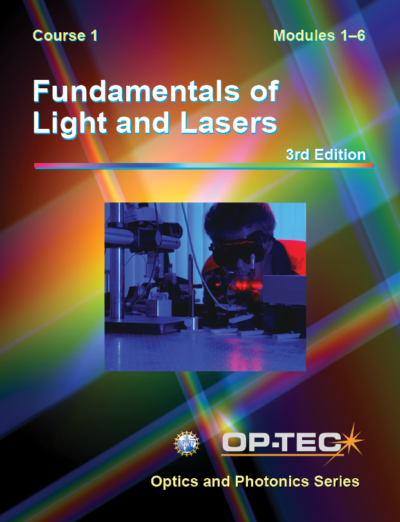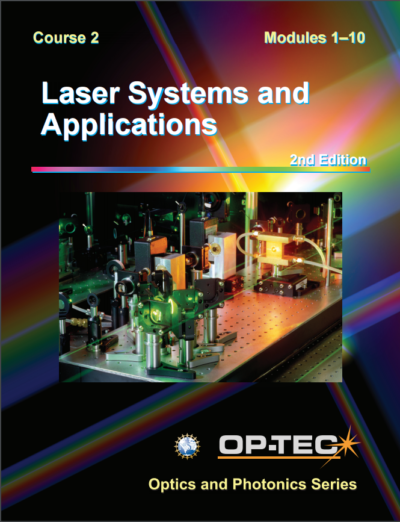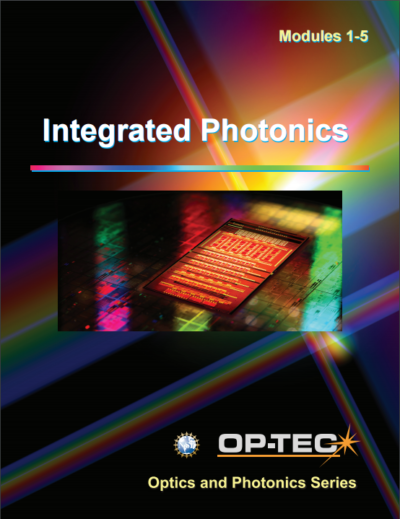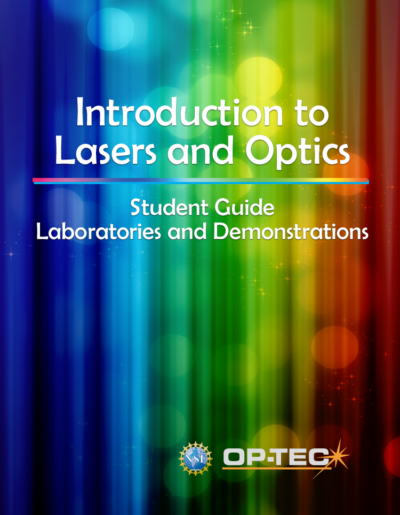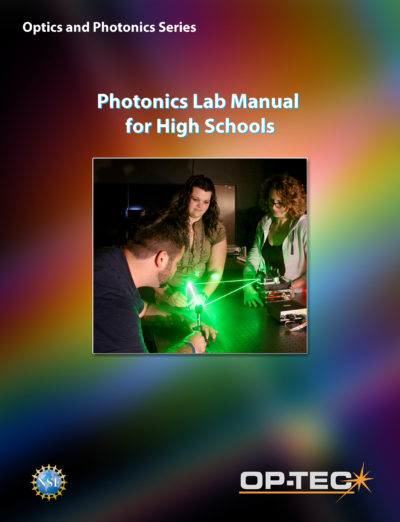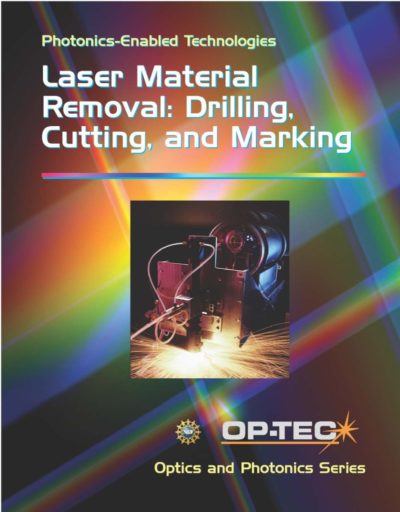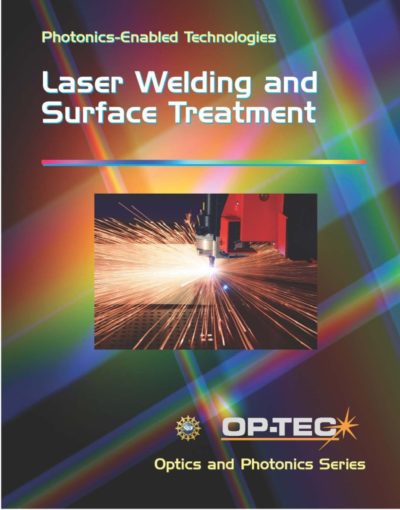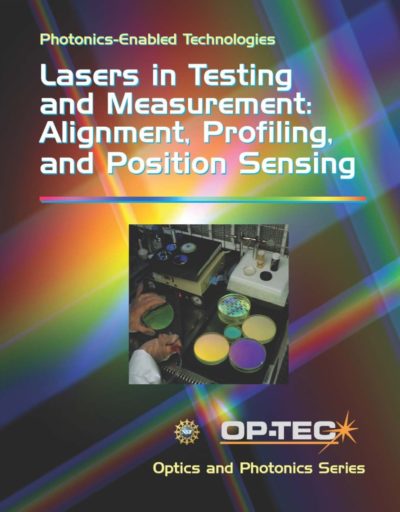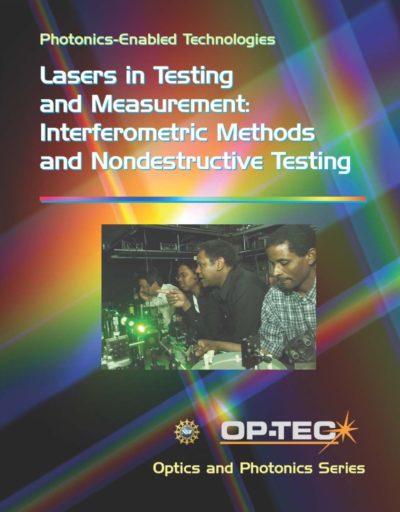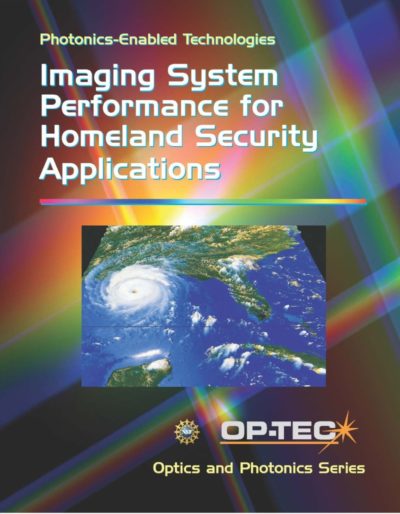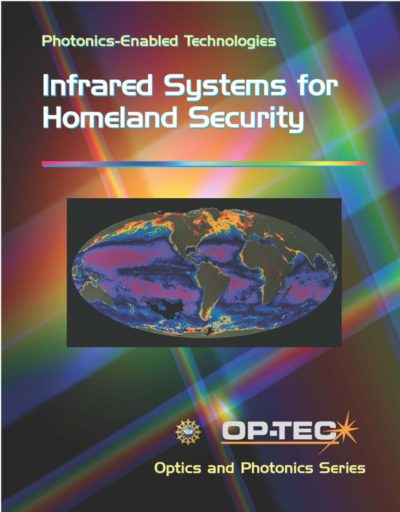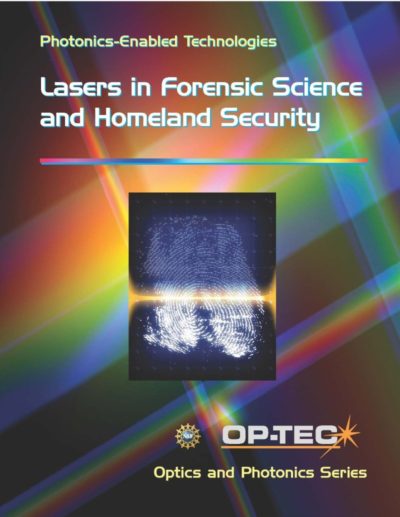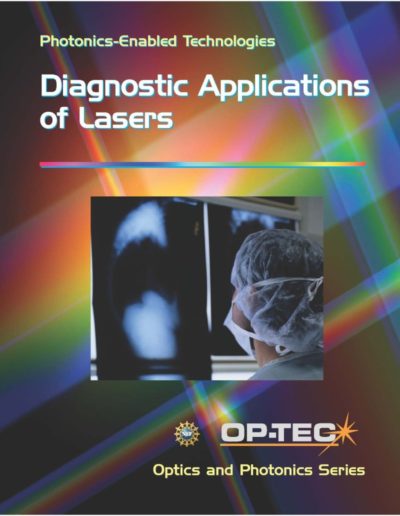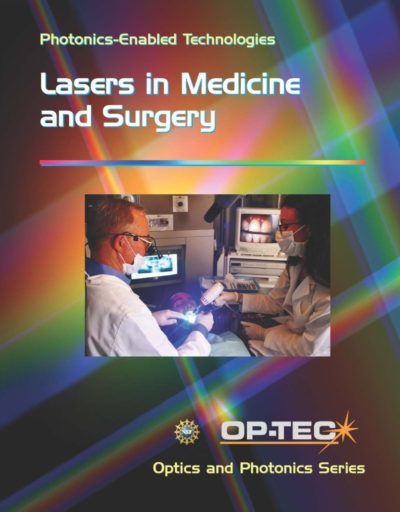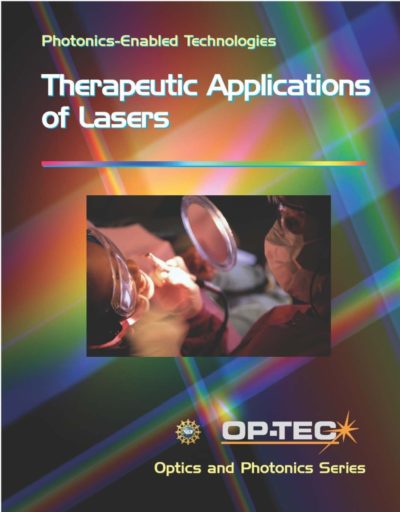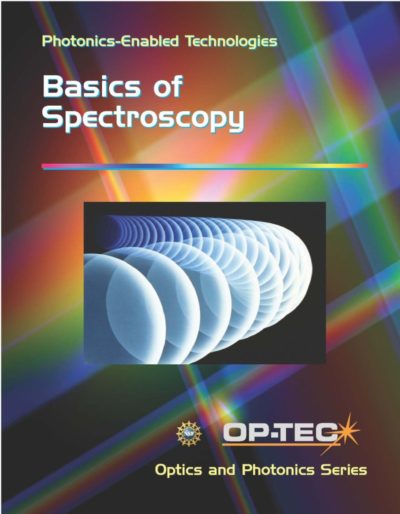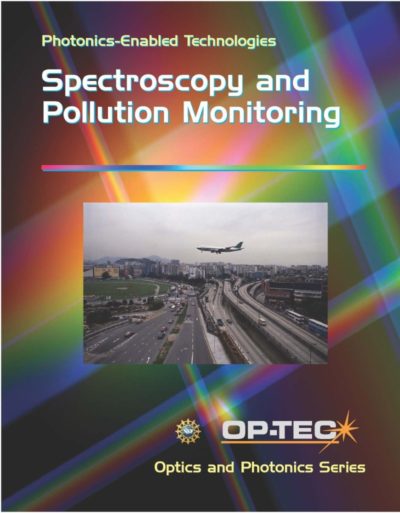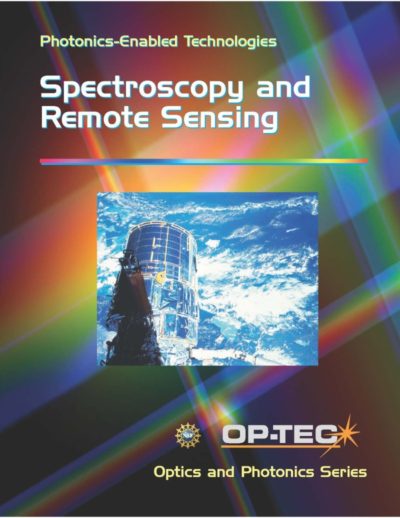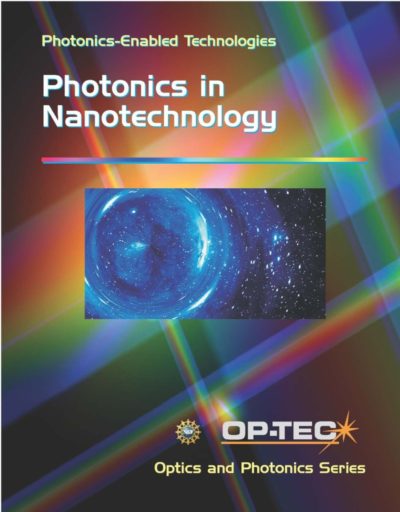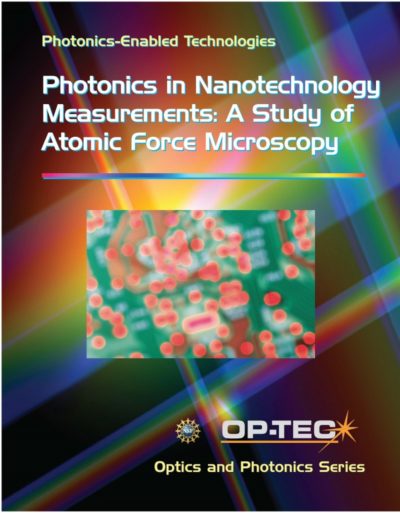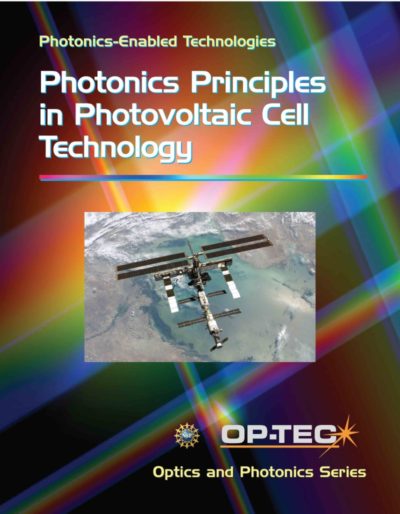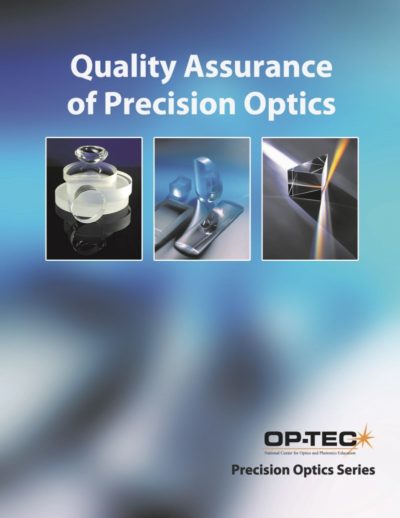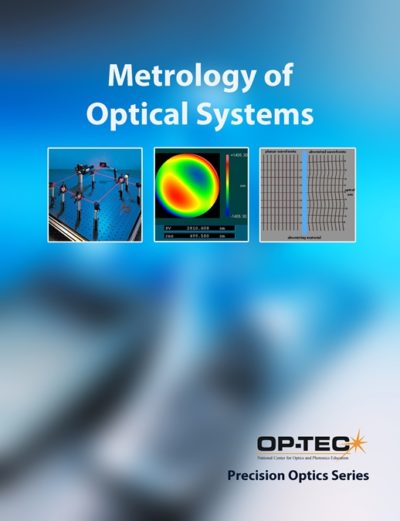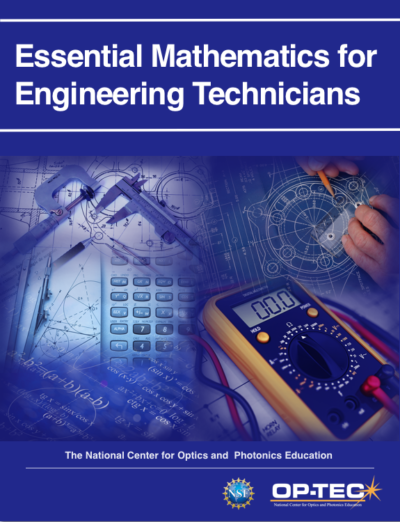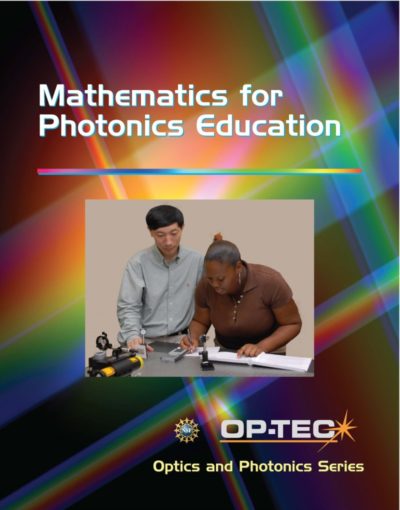Downloadable curricular materials developed by the National Center for Optics and Photonics Education (OP-TEC) designed to support optics, laser, and photonics education in high schools and two-year colleges, and the retraining of adult workers.
Laser Optics & Photonics Series
Course 1: Fundamentals of Light and Lasers, 3rd Edition
Module 1-1: Nature and Properties of Light
Module 1-2: Optical Handling and Positioning
Module 1-3: Light Sources and Laser Safety
Module 1-4: Basic Geometrical Optics
Module 1-5: Basic Physical Optics
Module 1-6: Principles of Lasers
Author(s): OP-TEC: National Center for Optics and Photonics Education
ISBN: 978-0-9998536-4-1
Publisher: OP-TEC
Year: 2018
Category: General Optics & Photonics
Recommended Grade Level: College – 2nd year
Support Files:
PDF: FLL_Figures_and_Images_for_Instructors_Module_1-1_Nature_and_Properties_of_Light_3rd_Ed
PPT: FLL_Figures_and_Images_for_Instructors_Module_1-1_Nature_and_Properties_of_Light_3rd_Ed
PDF: FLL_Figures_and_Images_for_Instructors_Module_1-2_Optical_Handling_and_Positioning_3rd_Ed
PPT: FLL_Figures_and_Images_for_Instructors_Module_1-2_Optical_Handling_and_Positioning_3rd_Ed
PDF: FLL_Figures_and_Images_for_Instructors_Module_1-3_Light_Sources_and_Laser_Safety_3rd_Ed
PPT: FLL_Figures_and_Images_for_Instructors_Module_1-3_Light_Sources_and_Laser_Safety_3rd_Ed
PDF: FLL_Figures_and_Images_for_Instructors_Module_1-4_Basic_Geometrical_Optics_3rd_Ed
PPT: FLL_Figures_and_Images_for_Instructors_Module_1-4_Basic_Geometrical_Optics_3rd_Ed
PDF: FLL_Figures_and_Images_for_Instructors_Module_1-5_Basic_Physical_Optics_3rd_Ed
PPT: FLL_Figures_and_Images_for_Instructors_Module_1-5_Basic_Physical_Optics_3rd_Ed
PDF: FLL_Figures_and_Images_for_Instructors_Module_1-6_Principles_of_Lasers_3rd_Ed
PPT: FLL_Figures_and_Images_for_Instructors_Module_1-6_Principles_of_Lasers_3rd_Ed
Course 2: Laser Systems and Applications, 2nd Edition
Course 2, Laser Systems and Applications, 2nd Edition, contains the following ten modules:
1. Laser Q-Switching, Mode Locking, and Frequency Doubling
2. Laser Output Characteristics
3. Laser Types and Their Applications
4. Carbon Dioxide Lasers and Their Applications
5. Fiber Lasers and Their Applications
6. Diode Lasers and Their Applications
7. Argon-Ion Lasers and Their Applications
8. Nd:YAG Lasers and Their Applications
9. Excimer Lasers and Their Applications
10. Systems Integration in Photonics
Features:
- Complete indexes, located at the end of each module.
- An “Acronym Glossary,” located at the back of the text.
- Lab videos, showing setup, operation, safety precautions and some measurements.
- Copies of all the figures used in the modules. A PDF and a PowerPoint version are available.
- Student Assignment Videos: A listing of 5-8 minute videos that will further explain the content or demonstrate an application for each of the first 9 modules.
- Student Assignment Questions for use with each video.
Laser Systems: Operating principles, output characteristics, diagnostics, and applications for the six most widely used laser types. All important lasers are described and classified according to their active medium, output wavelength, and applications.
Real-World Applications: Students want to know what skills and knowledge they will need to succeed in future jobs and what kinds of responsibilities they might be assigned in the workplace. This text has three features that address these interests and bring real-world context to its content.
Safety Considerations: Students must understand that a main consideration of any photonics technician is safety. Technicians working in the photonics industry are constantly exposed to a variety of radiation sources that can pose safety hazards. To eliminate or minimize these hazards, students must learn the safety protocols for these radiation sources and know how to implement them. To facilitate this learning, each module includes a special section called Safety Considerations. This section provides information on these protocols and explains to students technicians’ responsibilities in implementing them.
Troubleshooting Strategies: A prime skill that photonics technicians must master is troubleshooting. All students preparing for careers as photonics technicians need to study and practice the methodology of determining the source of failure in a system. The topic of troubleshooting is integrated throughout the course to provide students with basic strategies for determining the sources of failure in malfunctioning photonics systems and identifying common failure modes in various types of lasers. As they study these troubleshooting strategies, students will experience first-hand the work they will do as photonics technicians and will gain a sense of the skills and knowledge that employers will expect them to have.
Workplace Scenarios: These problem-based activities allow students to work in groups to generate solutions to problems that can arise in today’s photonics organizations. Students take on technician roles as they work together in teams to use the material in each module to develop strategies for completing assigned tasks. These activities also give students an opportunity to enhance their writing skills: many activities require a report written in the form of an e-mail message or memorandum.
Navigation Enhancements: Features and additions to supplement navigation within the text.
Acronym Glossary: A comprehensive listing of the acronyms found within Laser Systems and Applications. Acronyms are listed and defined in alphabetical order. The Acronym Glossary can be found after Module 2-10.
Module Indexes: Each module contains an alphabetical listing of terms and ideas contained within that module, and the page numbers where they can be found.
Author(s): University of Central Florida, National Center for Optics and Photonics Education
ISBN: 978-0-9858006-5-9
Publisher: OP-TEC
Year: 2016
Category: General Optics & Photonics
Recommended Grade Level: College – 2nd Year
Support Files:
PPT: LSA_Figures_and_Images_Module_2-1_Laser_Q-Switching_Mode_Locking_Freq_Doubling
PDF: LSA_Figures_and_Images_for_Instructors_Module_2-1_Laser_Q-Switching_Mode_Locking_Freq_Doubling
PPT: LSA_Figures_and_Images_for_Instructors_Module_2-2_Laser_Output_Characteristics
PDF: LSA_Figures_and_Images_for_Instructors_Module_2-2_Laser_Output_Characteristics
PPT: LSA_Figures_and_Images_for_Instructors_Module_2-3_Laser_Types_and_Their_Applications
PDF: LSA_Figures_and_Images_for_Instructors_Module_2-3_Laser_Types_and_Their_Applications
PPT: LSA_Figures_and_Images_Module_2-4_Carbon_Dioxide_Lasers_and_Their_Applications
PDF: LSA_Figures_and_Images_for_Instructors_Module_2-4_Carbon_Dioxide_Lasers_and_Their_Applications
PPT: LSA_Figures_and_Images_for_Instructors_Module_2-5_Fiber_Lasers_and_Their_Applications
PDF: LSA_Figures_and_Images_for_Instructors_Module_2-5_Fiber_Lasers_and_Their_Applications
PPT: LSA_Figures_and_Images_for_Instructors_Module_2-6_Diode_Lasers_and_Their_Applications
PDF: LSA_Figures_and_Images_for_Instructors_Module_2-6_Diode_Lasers_and_Their_Applications
PPT: LSA_Figures_and_Images_for_Instructors_Module_2-7_Argon-Ion_Lasers_and_Their_Applications
PDF: LSA_Figures_and_Images_for_Instructors_Module_2-7_Argon-Ion_Lasers_and_Their_Applications
PPT: LSA_Figures_and_Images_for_Instructors_Module_2-8_Nd_YAG_Lasers_and_Their_Applications
PDF: LSA_Figures_and_Images_for_Instructors_Module_2-8_Nd_YAG_Lasers_and_Their_Applications
PPT: LSA_Figures_and_Images_for_Instructors_Module_2-9_Excimer_Lasers_and_Their_Applications
PDF: LSA_Figures_and_Images_for_Instructors_Module_2-9_Excimer_Lasers_and_Their_Applications
PPT: LSA_Figures_and_Images_for_Instructors_Module_2-10_Systems_Integration_in_Photonics
PDF: LSA_Figures_and_Images_for_Instructors_Module_2-10_Systems_Integration_in_Photonics
Enhancements_and_Faculty_Tools_for_Course_2_Laser_Systems_and_Applications_2nd_Edition_2018
Integrated Photonics
Content covered includes:
- Photonics Integrated Circuits Material and Fabrication Technologies
- Silicon Photonics Integrated Circuits and Devices
- III-V and Compound Semiconductor Devices
- Dielectric and Polymer Waveguides and Waveguide Devices
- Integrated Photonics Circuits and Systems
This course is an excellent introduction to integrated photonics, both for students and industry professionals looking to learn more about an expanding technology.
Support Files:
PPT: IP_Figures_and_Images_for_Instructors_Module_1_Photonic_Integrated_Circuits
PDF: IP_Figures_and_Images_for_Instructors_Module_1_Photonic_Integrated_Circuits
PPT: IP_Figures_and_Images_for_2_Silicon_Photonic_Integrated_Circuits
PDF: IP_Figures_and_Images_for_2_Silicon_Photonic_Integrated_Circuits
PPT: IP_Figures_and_Images_for_Instructors_Module_3_III-V_Semiconductor_Devices
PDF: IP_Figures_and_Images_for_Instructors_Module_3_III-V_Semiconductor_Devices
PPT: IP_Figures_and_Images_for_Instructors_Module_4_Dielectric_and_Polymer_Waveguides
PDF: IP_Figures_and_Images_for_Instructors_Module_4_Dielectric_and_Polymer_Waveguides
PPT: IP_Figures_and_Images_for_Instructors_Module_5_Integrated_Photonic_Circuits
PDF: IP_Figures_and_Images_for_Instructors_Module_5_Integrated_Photonic_Circuits
Introduction to Lasers and Optics
Introduction to Lasers and Optics is an introductory course for students who have limited prior knowledge of lasers, optics, or photonics. The purpose of this course is to provide entering students with an overview of the technology and its applications. This modular course requires no prerequisites, and can be taught for one or two-credits in the first term. The course contains 15 modules that cover topics such as the spectrum of light, laboratory safety, polarization, mirrors and lenses, and more. These modules can be used all together or faculty can select the appropriate number of modules to fit the desired breadth and depth of study for the course. This course introduces the basic principles of light, lasers and laser safety that are needed to study specific types of laser systems. It also provides exposure to the topics that make up the foundation for studying the applications of lasers in telecommunications, electro-optical displays, biomedical equipment, manufacturing/materials processing, defense/homeland security, environmental monitoring, and nanotechnology.
There are seven laboratory demonstrations and activities that illustrate key concepts and support hands-on learning. It is recommended that the activities contained in this resource be set up by a teaching assistant or instructor and used to demonstrate concepts discussed in the modules of the course. The seven demonstrations are Spectrum of Light, The Polarization of Light, Optical Filters, Prisms and Lenses, Interference and Diffraction with a Single Slit, Interference and Diffraction with a Pinhole, and Beam Divergence.
A Reference Guide for Instructors is available for course instructors.
Author(s): OP-TEC: National Center for Optics and Photonics Education
ISBN: 978-0-9998536-0-3
Publisher: OP-TEC
Year: 2017
Category: General Optics & Photonics
Recommended Grade Level: College – 1st year
Introduction_to_Lasers_and_Optics_Reference_Guide_for_Instructors_2017
Photonics Enabled Technologies Modules: Manufacturing
Laser Material Removal: Drilling, Cutting, and Marking
Author(s): CORD Communications
ISBN
1-57837-396-4
Publisher: CORD
Year: 2008
Category: PET Module: Manufacturing
Laser Welding and Surface Treatment
Author(s): CORD Communications
ISBN
1-57837-395-6
Publisher: CORD
Year: 2008
Category: PET Module: Manufacturing
Lasers in Testing and Measurement: Alignment, Profiling, and Position Sensing
Author(s): CORD Communications
ISBN
1-57837-397-2
Publisher: CORD
Year: 2008
Category: PET Module: Manufacturing
Lasers in Testing and Measurement: Interferometric and Nondestructive Testing
Author(s): CORD Communications
ISBN
1-57837-398-0
Publisher: CORD
Year: 2008
Category: PET Module: Manufacturing
Photonics Enabled Technologies Modules: Forensic Science and Homeland Security
Imaging System Performance for Homeland Security
Author(s): CORD Communications
ISBN
1-57837-487-1
Publisher: CORD
Year: 2008
Category: PET Module: Forensic Science and Homeland Security
Infrared Systems for Homeland Security
Author(s): CORD Communications
ISBN
1-57837-486-3
Publisher: CORD
Year: 2008
Category: PET Module: Forensic Science and Homeland Security
Lasers in Forensic Science and Homeland Security
Author(s): CORD Communications
ISBN
1-57837-400-6
Publisher: CORD
Year: 2008
Category: PET Module: Forensic Science and Homeland Security
Photonics Enabled Technologies Modules: Biomedicine
Diagnostic Applications of Lasers
Author(s): CORD Communications
ISBN
1-57837-491-2
Publisher: CORD
Year: 2008
Category: PET Module: Biomedicine
Lasers in Medicine and Surgery
Author(s): CORD Communications
ISBN
1-57837-399-9
Publisher: CORD
Year: 2008
Category: PET Module: Biomedicine
Therapeutic Applications of Lasers
Author(s): CORD Communications
ISBN
1-57837-490-1
Publisher: CORD
Year: 2008
Category: PET Module: Biomedicine
Photonics Enabled Technologies Modules: Environmental Monitoring
Basics of Spectroscopy
Author(s): CORD Communications
ISBN
1-57837-501-0
Publisher: CORD
Year: 2008
Category: PET Module: Environmental Monitoring
Spectroscopy and Pollution Monitoring
Author(s): CORD Communications
ISBN
1-57837-492-8
Publisher: CORD
Year: 2008
Category: PET Module: Environmental Monitoring
Spectroscopy and Remote Sensing
Author(s): CORD Communications
ISBN
1-57837-493-6
Publisher: CORD
Year: 2008
Category: PET Module: Environmental Monitoring
Photonics Enabled Technologies Modules: Optoelectronic
Photonics in Nanotechnology
Author(s): CORD Communications
ISBN
1-57837-485-5
Publisher: CORD
Year: 2008
Category: PET Module: Optoelectrics
Photonics in Nanotechnology Measurement: A study of Atomic Force Microscopy
Author(s): CORD Communications
ISBN
1-57837-485-5
Publisher: CORD
Year: 2008
Category: PET Module: Optoelectrics
Photonics Principles in Photovoltaic Cell Technology
Author(s): CORD Communications
ISBN
1-57837-548-7
Publisher: CORD
Year: 2009
Category: PET Module: Optoelectrics
Precision Optics Series
Quality Assurance of Precision Optics
Author(s): OP-TEC: National Center for Optics and Photonics Education
ISBN: 978-0-9858006-3-5
Publisher: University of Central Florida
Year: 2013
Category: General Optics & Photonics
Recommended Grade Level: College – 2nd year
Support Files:
PPT: QAPO_Figures_and_Images_Module_1_Fabrication_of_Precision_Optics
PDF: QAPO_Figures_and_Images_Module_1_Fabrication_of_Precision_Optics
PPT: QAPO_Figures_and_Images_Module_2_Characterization_of_Optical_Materials
PDF: QAPO_Figures_and_Images_Module_2_Characterization_of_Optical_Materials
PPT: QAPO_Figures_and_Images_Module_3_Specifications_and_Drawings_for_Precision_Optics
PDF: QAPO_Figures_and_Images_Module_3_Specifications_and_Drawings_for_Precision_Optics
Metrology of Optical Systems
Author(s): OP-TEC: National Center for Optics and Photonics Education
ISBN: 978-0-9858006-4-2
Publisher: University of Central Florida
Year: 2015
Category: General Optics & Photonics
Recommended Grade Level: College – 2nd year
Support Files:
PDF: MOS_Figures_and_Images_for_Instructors_Module_1_Optical_System_Parameters
PPT: MOS_Figures_and_Images_for_Instructors_Module_1_Optical_System_Parameters
PPT: MOS_Figures_and_Images_for_Instructors_Module_2_Non_Interfererometric_Measurement
PDF: MOS_Figures_and_Images_for_Instructors_Module_2_Non_Interfererometric_Measurement
PPT: MOS_Figures_and_Images_for_Instructors_Module_3_Using_Interferometry_to_Measure
PDF: MOS_Figures_and_Images_for_Instructors_Module_3_Using_Interferometry_to_Measure
Mathematics Materials
Essential Mathematics for Engineering Technicians
Author(s): CORD / OP-TEC
ISBN:
PDF: 978-0-9903125-4-3
Publisher: OP-TEC / University of Central Florida
Year: 2015
Category: Math Supplements
- Scientific Notation
- Unit Conversion
- Introductory Algebra
- Powers and Roots
- Ratio and Proportion
- Exponents and Logarithms
- Graphing in Rectangular Coordinates
- Geometry
- Angle Measures in Two and Three Dimensions
- Trigonometry
- Special graphs
- Sinusoidal Motion
- Complex Numbers
The material in Mathematics for Engineering Technicians is intended for use by ET faculty to assist their students in understanding technical concepts and acquire problem-solving skills.
Mathematics for Photonics Education Supplemental Text
Topics Include:
- Scientific Notation & Unit Conversion
- Introductory Algebra/Geometry/Trig
- Powers & Roots/Ratio & Proportion
- Exponents & Logarithms
- Graphing
- Angle Measures in Two & Three Dimensions
Author(s): CORD
ISBN:
1-57837-352-2
Publisher: CORD
Year: 2003
Category: Math Supplements

This work is licensed under a Creative Commons Attribution-NonCommercial-NoDerivatives 4.0 International License
